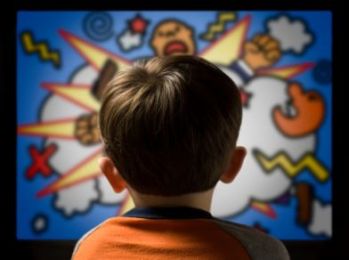UAlbany Study: TV Exposure may be Associated With Aggressive Behavior in Young Children
Contact(s): Catherine Herman (518) 956-8150
 |
A UAlbany-led study in Archives of Pediatrics and Adolescent Medicine links TV exposure with an increased risk of agressive behavior. |
ALBANY, N.Y. (November 2, 2009) -- Three-year-old children who are exposed to more TV appear to be at an increased risk for exhibiting aggressive behavior, according to a report by researchers at the University at Albany and Tulane University. The article, by UAlbany School of Public Health researcher and lead author Jennifer Manganello, was published in the November issue of Archives of Pediatrics & Adolescent Medicine, one of the JAMA/Archives journals.
"Early childhood aggression can be problematic for parents, teachers and childhood peers and sometimes is predictive of more serious behavior problems to come, such as juvenile delinquency, adulthood violence and criminal behavior," according to background information in the article. Various predictive factors for childhood aggression have been studied. These include parents� discipline style, neighborhood safety and media exposure. "After music, television is the medium children aged 0 to 3 years are exposed to the most." Although the American Academy of Pediatrics recommends no screen media for children younger than age 2, studies have found consistent use of television in that age group.
Manganello, an assistant professor in the Dept. of Health Policy Management and Behavior, and co-investigator Catherine A. Taylor of Tulane's School of Public Health and Tropical Medicine analyzed data from 3,128 mothers of children born from 1998 to 2000 in 20 large U.S. cities to examine associations of child television exposure and household television use with aggressive behavior in children. Parents were interviewed at the time of the child's birth and at one and three years. At three years, they were asked to report time the child spent watching TV directly as well as household TV use on a typical day. Aggression was assessed using a 15-item aggressive subscale for 2- and 3-year-old children. Demographic information and other risk factors for aggression were also noted.
About two-thirds (65 percent) of mothers reported that their child watched more than two hours of television per day. On average, children were exposed to an additional 5.2 hours of household TV use per day.
 |
Jennifer Manganello, Assistant Professor of Health Policy Management and Behavior, University at Albany School of Public Health (Photo Mark Schmidt) |
Direct child TV exposure and household TV use were both significantly associated with childhood aggression, after accounting for other factors such as parent, family, neighborhood and demographic characteristics. "One explanation that could link both child and household TV measures with aggression involves the parenting environment," the authors write. Households with higher rates of TV use may have fewer restrictions on children�s viewing habits such as exposure to unregulated television content. Increased household television use may also affect daily routines such as eating and communication patterns and may decrease time spent on other activities.
�Current American Academy of Pediatrics recommendations mainly suggest limitations for direct child exposure to TV and other media; however, our findings suggest that additional household TV use may also be an important predictor of negative childhood outcomes, such as early childhood aggression," said Manganello. "Future research in this area should consider inclusion of both of these TV variables along with additional parent-child interaction assessments, observational assessments when possible, quality and/or content of TV programs and longitudinal analyses."
Follow the University at Albany on Facebook and Twitter.
![]() For more news, subscribe to UAlbany's RSS headline feeds
For more news, subscribe to UAlbany's RSS headline feeds
Educationally and culturally, the University at Albany-SUNY puts "The World Within Reach" for its 18,000 students. An internationally recognized research university with 58 undergraduate majors and 128 graduate degree programs, UAlbany is a leader among all New York State colleges and universities in such diverse fields as public policy, nanotechnology and criminal justice. With a curriculum enhanced by 300 study-abroad opportunities, UAlbany launches great careers. For more information about this globally ranked University, visit www.albany.edu. For UAlbany's extensive roster of faculty experts, visit www.albany.edu/news/experts.shtml.


